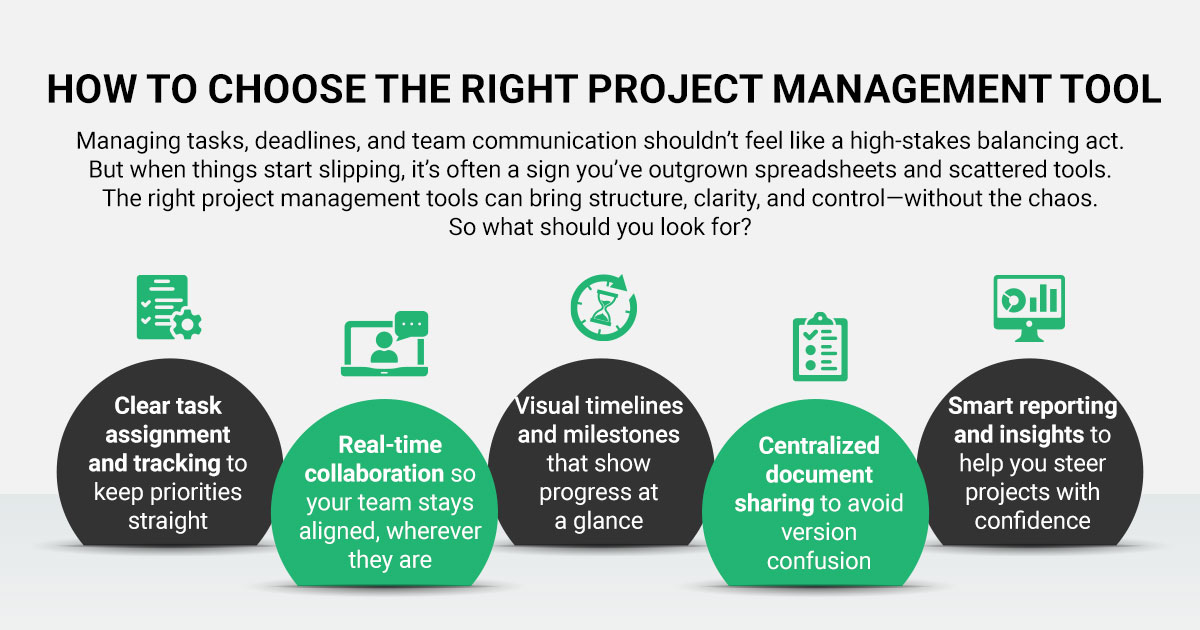
Quick Summary: In a high-stakes, speed-driven business environment, relying solely on traditional project management tools or standalone techniques is no longer enough. This article exposes the limitations of static systems like spreadsheets and even conventional software, urging leaders to embrace predictive intelligence for real project assurance. It outlines 22 essential tools and techniques every project leader must know, while making a compelling case for AI-powered project management—where real-time foresight, risk mitigation, and stakeholder alignment redefine execution. The message is clear: the future isn’t just about managing projects—it’s about anticipating what’s next. And that’s where TrueProject leads the way.
Relying on spreadsheets and static to-do lists might get you past deadlines—but not without the cost of miscommunication, delays, or burnout. A project management tool offers the structure, visibility, and collaboration that today’s fast-paced, high-stakes work environment demands. Whether you're leading cross-functional teams or managing solo projects, tools like Kanban boards, calendar views, and task trackers are no longer optional—they're foundational.
Yet tools alone aren’t enough. While project management tools from trusted vendors give teams a head start, execution fails without the right strategies. That’s where proven project management techniques offer frameworks to plan, organize, and deliver across timelines, budgets, and scope.
But here’s the strategic truth: tools and techniques will only take you so far. Real project assurance requires foresight, which is made possible by the artificial intelligence-powered predictive project management solution. Without it, even the most advanced tools can fall short. The predictive project management solution transforms traditional tools from reactive tracking into proactive risk mitigation, stakeholder alignment, and real-time insight. And that’s the difference between hitting a milestone and missing the mark.
In this article, we’ll explore why having the right project management solution is essential for operational efficiency, what features truly align with your team’s workflows and leadership approach, and how integrating predictive intelligence can significantly elevate your current system’s effectiveness.
Why Every Organization Needs a Modern Project Management Tool
The last few years have reshaped the global business landscape. From the COVID-19 crisis to widespread workforce shifts and cost-cutting mandates, organizations have faced a relentless demand to do more with less. In this environment, the need for a high-performance project management solution is a survival strategy.
When teams operate in silos, workflows lack structure, and critical work isn’t visible, organizations bleed productivity. The impact is massive. Studies reveal:
- 13.7 hours lost weekly per knowledge worker due to fragmented systems and poor visibility
- $16,500 in annual productivity loss per employee
- 89 business days wasted each year
- $52 million in wasted potential for a company of just 1,000 knowledge workers
These numbers point to one thing: without a system that unifies work, aligns execution, and accelerates delivery, organizations are sacrificing business value every day.
Organizations must invest in project management tools that offer more than task tracking to recover that lost ground. It must drive:
- Operational speed and responsiveness
- Seamless adaptability across use cases
- End-to-end visibility and accountability
- Scalable architecture powered by intelligent automation
However, even the most advanced project management tools fall short if they operate in isolation. True execution excellence comes only when these tools are integrated with AI-driven predictive intelligence. Techniques and tools alone can organize work; predictive intelligence transforms it, empowering teams with foresight, real-time risk detection, and data-backed decision-making.

That’s where the future of project management lies—not just in control, but in strategic clarity.
To fully capitalize on the promise of modern project management, however, leaders must distinguish between the tools that enable execution and the techniques that shape strategic outcomes. That distinction is not just academic—it’s operationally vital.
It’s time to stop relying on outdated systems that track tasks and start driving outcomes with strategic clarity. Start building a smarter, faster, more resilient organization today—discover how TrueProject transforms project chaos into clarity.
Project Management Tools vs. Techniques: What You Need to Know
In project management, tools and techniques are often used interchangeably, but they’re far from the same. Understanding this distinction is critical for leaders seeking to optimize project outcomes in high-stakes environments.
Tools: The Execution Layer
Project management tools are your tactical enablers. Think of them as the infrastructure that powers execution—software platforms, visual boards, templates, charts, and dashboards that help operationalize the “how” of project delivery. Whether it’s a Gantt chart aligning timelines or a Kanban board visualizing workflows, these tools are about streamlining, organizing, and tracking progress in real time. They improve collaboration, increase visibility, and facilitate smoother planning cycles. However, tools alone cannot guarantee executive success.
Techniques: The Strategic Foundation
On the other hand, project management techniques are about methodology. These frameworks, philosophies, and structured approaches define what gets done and why. Agile, Scrum, Critical Path Method, and Lean dictate how projects are scoped, scheduled, iterated, and delivered. Techniques ensure consistency, predictability, and alignment to business goals. They’re the strategic blueprint guiding every project decision.
Knowing the difference between tools and techniques is only the beginning—what truly drives impact is applying the right combination of both. From visualization frameworks to strategic methodologies, every leader should have 22 essential project management tools and techniques in their arsenal.

22 Project Management Tools and Techniques Every Project Leader Should Know
Project professionals must command 22 essential techniques and tools from foundational frameworks to advanced analytics. Here are some project management tools and techniques that you must know.
Top Project Management Tools:
1. Gantt Charts
Gantt charts are a foundation of scheduling and offer a visual project timeline. They simplify task sequencing, dependencies, and resource allocation—ideal for strategic planning and progress tracking across portfolios.
2. Work Breakdown Structure (WBS)
The WBS dissects a complex project into manageable components. It delivers clarity and control by aligning every granular task to high-level deliverables—a powerful CPM or PERT implementation structure.
3. Cost Breakdown Structure (CBS)
Want control over your budget? CBS structures project budgets hierarchically, making it easier to allocate, monitor, and analyze expenditures by category. This structure is foundational for financial forecasting and cost control.
4. Resource Breakdown Structure (RBS)
The RBS categorizes personnel, equipment, and materials to align resources with deliverables, so you’re not guessing who’s doing what. This method is particularly effective in enterprise environments where cross-project visibility is crucial.

5. Project Network Diagrams
These diagrams map task sequences using nodes and directional arrows, highlight dependencies, and enable effective scheduling. They're integral to both PERT and Critical Path techniques.
6. Kanban Boards
Kanban enables real-time visualization of workflow. It minimizes work-in-progress bottlenecks and supports Agile execution through efficient task management and team coordination. It's not about sticky notes but flow, discipline, and throughput.
7. Risk Register
Every project has risks. The question is: do you know them? A risk register captures, assesses, and mitigates risks by enabling proactive risk governance, assigning ownership, ranking severity, and documenting contingency plans.
8. Risk Matrix
This grid-based tool helps evaluate the probability and impact of potential risks—providing an objective way to prioritize and escalate response strategies.
9. Timesheets
Beyond just clocking hours, timesheets show where project time actually goes. Use them to identify overloads, missed effort, or work that adds no value.
10. Project Dashboards
Dashboards turn raw metrics into actionable insights. They consolidate cost, schedule, and resource data into executive-level overviews that support informed, strategic decision-making.
11. Change Log
Scope creep is real. The change log captures all requests, detailing their origin, justification, impact, and status. It safeguards against scope creep and supports audit trails and stakeholder communication.
12. Project Reports
From status updates to variance and workload analyses, structured project reporting offers visibility into execution gaps and provides a record for stakeholders and leadership.
Top Project Management Techniques:
13. RACI Charts
RACI clarifies roles. It tells your team who owns it, who signs off, who’s in the loop, and who needs to stay informed. This prevents ambiguity and improves team accountability.
14. RAID Logs
RAID—Risks, Assumptions, Issues, Dependencies—logs act as centralized control mechanisms that help project managers foresee roadblocks and stay ahead of project derailments.
15. Agile Project Management
Agile project management methods are for teams that move quickly and iterate faster. Agile isn’t just about speed. It’s about adaptability, transparency, and customer focus, often executed using Kanban boards and burndown charts. Therefore, project managers must use it where innovation matters more than rigidity.
16. PERT (Program Evaluation and Review Technique)
PERT employs probabilistic time estimates and network diagrams to improve schedule reliability, which is ideal for high-uncertainty projects.
17. Critical Path Method (CPM)
Not all tasks are created equal. CPM shows you the ones you cannot afford to delay, giving project leaders a laser focus on the schedule’s non-negotiables. It’s essential for identifying slack and maintaining timelines.
18. Cost-Benefit Analysis
Gut instinct doesn’t scale. This financial technique weighs the cost of execution against expected benefits. It helps prioritize initiatives based on projected ROI and strategic alignment.
19. Earned Value Management (EVM)
This is your scoreboard. EVM synchronizes scope, time, and cost for performance measurement. It enables early warning detection and predictive forecasting based on real-time variance.
20. Stakeholder Mapping
Every project has influencers—some helpful, some hazardous. Stakeholder mapping is a visual and strategic technique that classifies stakeholders by influence and interest. It informs targeted communication strategies and aligns stakeholder expectations with project realities.
21. Feasibility Studies
Conducted during initiation, feasibility studies assess whether a project is viable and aligned with organizational capacity, strategic intent, and expected value.
22. Project Pipeline Management
Every organization has more project ideas than capacity. Pipeline management enables centralized governance over active and proposed initiatives. It supports prioritization, resource allocation, and strategic project selection through visibility into the broader portfolio.

Mastering project management tools and techniques gives you structure—but structure alone isn't enough in a world defined by complexity, speed, and constant change. That’s why project leaders are turning to AI-powered project management tools to gain foresight, agility, and the precision today’s projects demand.
Traditional tools weren’t built to keep up with the pace and complexity of today’s multi-project landscape. Static dashboards, rigid templates, and reactive planning often leave leaders struggling to adapt.
Move beyond static dashboards and reactive planning—step into the future with AI-powered predictive project management that adapts, anticipates, and drives outcomes. See TrueProject in action—book your personalized demo now and discover what precision-led execution really looks like.
Why AI Project Management Software Is Worth the Shift
The growing influence of digitalization and big data demands smarter ways to drive project outcomes and make the most of available resources. The AI-powered project management tool addresses this shift by allowing organizations to manage projects and people with greater precision and impact.
1. Smarter Decision-Making
The predictive project management tool gives project leaders something they’ve long needed: clarity before commitment. With predictive insights, you can assess the ripple effects of a decision before it’s made—whether it’s reallocating resources, shifting priorities, or adjusting timelines. It’s not just data. It’s foresight.
2. Proactive Risk Handling
Anticipating risk is one thing. Responding to it effectively is another. AI-powered tools help you do both. They identify potential threats early and recommend the most effective way to manage them, minimizing impact or turning them into opportunities when the conditions are right.
3. Precision in Resource Management
No more guesswork about who’s available or overworked. The predictive project management tool assesses workloads and availability in real time to suggest the best-fit assignments. Think of it as having a strategic advisor on call who understands your team’s capabilities and constraints across all active projects.
4. Agility Under Pressure
When priorities shift or external variables change, the predictive project management tool lets you course-correct quickly. With scenario testing and impact simulations, you can evaluate your options quickly and confidently, choosing the path that keeps your project stable and moving forward.
5. Better Budget Control
Efficient decisions, optimal resource use, and streamlined execution influence project costs. The AI-powered project management tool helps monitor budgets by reducing delays, waste, and rework. And when you spend wisely, stakeholders notice.
6. Higher Project Success Rates
With improved planning, real-time tracking, early warnings, and smarter resource alignment, projects can meet deadlines, stay within budget, and achieve their goals—without last-minute chaos.
From Control to Clarity: Why Predictive Intelligence Is the Missing Link in Project Success
Project leaders can no longer rely on static project management tools or inherited methodologies in a business climate defined by shrinking margins, tighter timelines, and growing stakeholder scrutiny. The true differentiator isn’t just better planning—it’s smarter foresight. It’s not enough to know what’s happening; you need to know what will happen next. That’s why the future of project execution lies in predictive intelligence—a shift from reactive management to proactive assurance. It's about moving from checklists to clarity, from process to precision. And that’s precisely where TrueProject comes in.
TrueProject, a KPI-based predictive project management SaaS solution that improves project health and performance, takes control of project outcomes before risks take control of them. It integrates with your existing project tools, constantly collects real-time stakeholder feedback, detects early warning signals, and provides forward-looking insights that empower timely, informed decisions. Whether you’re managing five projects or fifty, TrueProject ensures alignment, mitigates risk, and protects value—before timelines slip or budgets spiral. Because in today’s high-stakes environment, visibility isn’t enough. You need predictability. And with TrueProject, that’s precisely what you get.
If you're still waiting for issues to surface before acting, you're already too late. It’s time to shift gears—from reacting to anticipating, from uncertainty to precision. Experience how TrueProject delivers real-time foresight and project assurance with QuickStart. Get started today and stay ahead—always.






